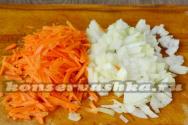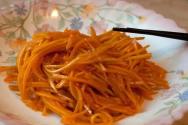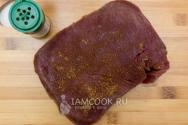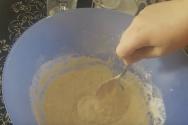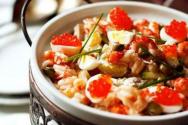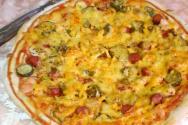How to make ghee at home? How to melt butter correctly? Making ghee at home

Throughout centuries of human history melted butter Ghee (Ghee) was perceived in India as a sign of prosperity and healthy eating. The ancient traditional system of medicine Ayurveda calls it “liquid gold” due to its unique qualities. Other nations also support the Indians, respecting this truly useful product.
However, after looking at the cost of small jars in the store, many decide not to purchase. The price of authentic oil is really steep, so not everyone can afford it. But there is no need to be upset, because you can make it at home. We will look at recipes for preparing Ghee in the oven and on the stove in our article.
This product, with a name unusual for the Russian ear, is essentially ordinary ghee from cow or goat milk. But it is prepared using a special method. This allows you to completely clean it of lactose, casein and other harmful impurities.
The main beneficial property of such fat is the absence of toxins and combustion products, even when heated to temperatures above 180-190 degrees Celsius. This means that it can even be used in recipes that require frying.
According to Ayurveda, ghee has rejuvenating, healing, tonic properties. It strengthens the immune system and normalizes the functioning of the gastrointestinal tract. The product increases the ability to concentrate and activates brain activity. Ghee has a beneficial effect on the regeneration of all tissues, including bone and nerve tissue, which is especially important. However, all these properties will manifest themselves only under proper preparation conditions.
How to choose a good oil


To prepare high-quality Ghee from ordinary domestic one, you will have to try. First of all, you need to choose the right raw materials. Simple tips from experienced people will help you with this.
- Clean butter a priori, it cannot have a fat content of less than seventy-eight percent. If this indicator is lower, then the product contains, at best, modified vegetable fats. At worst, there are unknown additives that are undesirable to use.
- A store-bought product must comply with GOST 37-91, be unsalted and unflavored. It is better not to purchase packages marked TU, even if the packaging says “natural” and the fat content is high. It usually contains a lot of additives. When heated, they form an unappetizing slurry and cannot be separated into fractions.
- When heated in a frying pan, a good quality product does not foam, but boils. It should emit tiny bubbles.
- After freezing, it will be impossible to cut the natural one - it breaks off into pieces.
- When stirred with boiling water, a homogeneous emulsion is formed. There should be no sediment, pieces, flakes or other “garbage” in it.
When heated, a high-quality product should not have a specific, much less a strong chemical odor. It should have a pleasant creamy aroma.
General nuances
Choosing the original product itself is very important. But the manufacturing process plays an equally important role.
- For heating, it is better to use saucepans with a thick bottom. They hold the temperature better and prevent food from burning. You can use a cauldron or casserole dish made of cast iron or glass. Enameled cookware and stainless steel will also work, but it’s better to avoid aluminum right away. It can oxidize, saturating your oil with chemicals it doesn't need.
- Prepare a slotted spoon in advance - you will need to frequently skim off the foam that forms on the surface.
- You can make Ghee in advance - it can be perfectly stored in the cellar or refrigerator for many months. The beneficial properties do not disappear over time.
- Ghee should not be allowed to darken - this is a clear sign of overheating. Its color should be light yellow, rich, like an egg yolk.
A sediment will certainly form at the bottom of the saucepan. It is good for nothing and contains a large amount of harmful substances. Therefore, it will have to be poured out.
Homemade Ghee: Oven and Stovetop Recipes


In order to do everything as needed and not spoil a rather expensive product, you will have to strictly follow the requirements and preparation rules. No special knowledge or special devices are required for this.
Please note that the more Gi you want to receive, the more time you will have to spend on the process. For example, melting half a kilo will take only sixty minutes, and ten kilograms will take seven and a half hours. This can be significantly speeded up by adding a teaspoon to the container. lemon juice for five hundred grams or a few pinches citric acid. However, the quality of the final product will suffer.
Cooking time and yield for different volumes
- 0.5 kg. - 1.6 hours, 350 grams.
- 1 kg. - 1.9-2.2 hours, 690 grams.
- 3 kg. - 3.7-4.0 hours, 1.9 kilograms.
- 5 kg. - 6.8-7.2 hours, 3.7 kilograms.
- 10 kg. - 9-10 hours, 8.2 kilograms.
- 12 kg. - 11-13 hours, 10.7 kilograms.
*When cooking in the oven, the time can be safely reduced by thirty minutes in each case.
Utensils and tools
- A saucepan of suitable size.
- Skimmer.
- Ladle.
- Wooden spatula.
- Sieve.
- Gauze or loose linen towel.
- Containers for further storage of the resulting product (jar, jug, pot, can).
- Vessel for removing noise.
Stovetop Ghee Recipe (Sada Ghee)


Since, regardless of the quantity, the manufacturing method is the same, the same kitchen utensils will be used. The only thing you need to remember is that the volume of the pan or cauldron must be larger than the volume of raw materials used. To melt two kilograms of oil, it is better to take a vessel for five. Ideally, there should be at least eight centimeters of free space above the surface of the melted Ghi.
Cooking method
For convenience, you can first cool the oil and then cut it into small pieces, about a hundred grams in each. Place all this in a saucepan and place on low heat. It needs to be stirred constantly and turned over with a natural wooden spatula. If it begins to sizzle or changes color to a darker color, reduce the heat.
- When it is completely melted, it will have to be increased in order for the product to boil. This can be determined by the smallest bubbles rising from the bottom.
- Next, the fire needs to be reduced to minimum again. The liquid should not boil, but simmer and warm up. There is no need to cover the container with a lid. So it can escape and ruin everything for you.
- After you have removed the flame, it is not recommended to stir the oil, as all impurities will settle in flakes at the bottom. There is no need to stir or lift them.
- Simmer until the thin crust on top becomes translucent. Using a slotted spoon, remove the crust.
It's time to take a closer look at what happened. It should be a light golden color, similar to honey. Its smell is usually pleasant, creamy caramel. If the color becomes darker or the aroma is sharp (burnt, chemical, acrid), then something has gone wrong. In this case, the sediment must be filtered off, and the ghee itself must be used for food. True, it will no longer have the healing properties of Ghee.
Place a sieve lined with several layers of gauze or a rough towel on top of the storage vessel. Carefully strain the entire product through it. It is optimal to immediately pour it into prepared containers, covering with lids. The dishes should be left for twelve hours until completely cooled. After this, you can store it in the refrigerator or cellar.
Ghee in the oven (Chula Ghee)


When the volumes of the required product are small, the best option is cooking on the stove. But when you need to melt five or ten kilograms of ghee, then the oven will come to the rescue. In it, the saucepan will heat up from all sides. This will prevent burning. The requirements for the dishes here are the same as in the previous recipe. But you don’t have to do practically anything - the oil will prepare itself, the dry residues will precipitate, and you will get a useful product for health and beauty.
Cooking method
- Cut the butter into small pieces and place in a saucepan.
- Preheat the oven to one hundred and fifty degrees Celsius and place the container with the future ghee in it. Close the door oven no need.
- Simmer without covering with a lid for the time indicated above. There is no need to stir it or remove noise, although some people do this.
- After the specified period, a thin translucent crust should form on the surface, and a sediment should appear at the bottom.
- Remove the crust and strain the Ghee in the same way as in the previous recipe.
The resulting product should be drained very carefully so as not to raise turbidity from the bottom. It is best to pour it immediately into the jars in which you will store it.
Do not rush to throw away the removed crusts and drained sediments that remain after preparing Ghee. They can be used for making soups, baking, even for spreading on sandwiches - it is tasty, slightly sweet. However, you cannot fry it, and it can be stored for no more than three or four days.
Water Bath Recipe (Bhusa Ghee)


To implement this cooking option, you will need not one, but two saucepans of different sizes. One should fit freely into the other, resting on the handles and not falling inside. With this method, the very possibility that the oil will burn, run off or overheat is eliminated.
Cooking method
- Cut the butter and place it in a smaller container, placing it inside a larger one filled with water.
- Wait until the water boils, constantly stirring and turning over the pieces of product.
- Reduce the gas so that the boiling process does not stop completely, but is not violent.
- After the sediment has separated, pure Ghee must be poured into another container. It doesn’t hurt to strain it through several layers of gauze or a towel.
- If the sediment has not completely fallen out or is difficult to separate, the container must be returned to the stove and heated further.
Once the light golden liquid is ready, pour it into a storage container. Please note that hot, high-quality gi will definitely be transparent and not cloudy. If this is not the case for you, warming up should be continued.
In the context of total promotion of healthy eating, many types of Ghee have appeared on the market, for example, vegetable. It is worth knowing that in fact this substance has absolutely nothing to do with a natural authentic product. It is produced on the basis of modified vegetable fats, which may be unsafe for health. It has a lower cost, but there will be no benefit from it.
- Ghi butter is the purest butter fat. It will not go rancid even if stored outside the refrigerator. Of course, if you did it according to the rules.
- When using Ghee for frying, make sure your pan is completely dry. If even a minimal amount of water gets in, the oil will “shoot” strongly, and the dish may stick to the bottom.
- Don't try to fry a lot of food in oil at once. It is better to lay them out in one layer. After all, they can significantly lower the temperature. Then the food will become saturated with oil and become excessively greasy.
- If the oil is overheated, the food may not be fried, although a golden brown crust will form on top. Therefore, it is very important to select the correct cooking temperature. For Ghee it should be no less than 120 and no more than 180 degrees.
You can re-fry food using already used ghee, but you will have to filter it each time through a linen towel or several layers of gauze. The main thing is that it does not darken and does not acquire an unpleasant bitter odor. This will be a clear sign that it has become unusable and it’s time to throw it away.
They say that ghee was the first to be prepared in India, where it is called Ghee.
Among Hindus, this oil is considered a very valuable product (like gold and grain), symbolizing the well-being of the family and having numerous healing properties.
Its main property is that it is beneficial for our liver - it is better absorbed by the body and helps in digesting food, promotes the removal of waste and toxins, and also protects against free radicals, which, of course, leads to increased immunity and preservation of youth.
Total cooking time – 1 hour 10 minutes
Active cooking time – 0 hours 15 minutes
Cost – average cost
Calorie content per 100 g - 748 kcal
Number of servings – 100 servings
How to make ghee
Ingredients:
Butter – 1 kg.
Preparation:
1. As the name suggests, ghee is just melted butter... albeit with a certain technique. During the melting process, butter is cleared of all solid impurities (lactose, for example), protein (casein, which increases the level of bad cholesterol in blood) and water.
And even after prolonged heat treatment, ghee is rich in antioxidants, vitamins A and E...
Ghee can be stored for quite a long time - up to 9-15 months, does not burn when frying, does not foam and does not smoke - important qualities! In addition, it has great taste, with a subtle nutty odor.
Ghee can be prepared in several ways: by slow and long heating (Oriental style), melting in a water bath, melting with some water (Russian style), as well as in the oven or using modern kitchen aids such as a slow cooker, for example... there are many ways - the essence is the same: to get healthy, pure oil without any impurities and water.
I will focus on the first method, the so-called Ghee oil.
What should you know before you decide to make ghee?
Firstly, the initial product - butter must be of high quality, with a fat content of at least 82% (preferably), and not containing any additives or salt.
Secondly, you should take a pan with a thick bottom - such sediment will not burn.
Thirdly, the heating time depends on the amount of oil. For 1 kilogram of oil it will take about 1 hour.
2. So, gradually melting, the oil will reach almost the boiling point. White foam will begin to appear on the surface. Then you need to reduce the heat to the lowest possible level (the oil should not bubble violently) and leave it to simmer further, without covering it with any lid - the water should evaporate.
3. So gradually more and more foam will appear, and a foam cap like this will form on the surface.
4. At first it will be airy, but at the same time quite oily. Therefore, do not rush to remove it, remove some of the oil along with the foam, but what do we need?!... let it simmer quietly...
Just remember – don’t stir it!
5. After some time, the foam will become noticeably less, it will no longer be so fluffy.
Now carefully remove it with a slotted spoon, giving time for the oil to drain back into the pan.
6. If desired, you can also strain through several layers of gauze into another pan, and then put it back on low heat to simmer further until the desired color and smell.
I do this in order to get rid of the sediment that has formed at the bottom of the pan - after all, it can still start to burn and can ruin the taste of the oil.

Continuing the topic of ghee, today I will share with you recipes using it.
Ghee is very healthy and delicious product, dishes prepared with it differ unusually delicate taste and aroma. They give the body “solar” energy and vigor.
Real ghee is an environmentally friendly product.
you can read about the beneficial properties of ghee and learn how to prepare it at home.
The simplest and tasty dish, these are potatoes fried in melted butter. It turns out rosy and fragrant.
Ghee does not burn or foam when heated, which means it does not emit harmful substances.
Fry over low heat and the result is a healthy and tasty dish.
The maximum heating temperature for ghee is 190 degrees; at higher temperatures, the oil begins to burn. Vegetable oil begins to burn already at 100 degrees, becoming carcinogenic.
We can conclude that foods fried in ghee are much healthier. Although medicine recommends not frying...

Boil the chicken, cut into pieces. Roll the pieces in breadcrumbs, then dip them in beaten egg and fry in melted butter. Pre-heat the pan and oil before frying. The chicken turns out very tasty.
Fish fried in sour cream
Any fish is suitable for this dish; take navaga, cod or haddock.
We wash the fish, remove the fins and bones, cut into pieces, add some salt and leave in the refrigerator for 30 minutes.
Dredge the fish pieces in flour and fry in melted butter until half cooked. Add sour cream and bring to readiness.
There is a delicious article on the site “”, and if you do this with ghee, it will be a fairy tale.
Chicken giblets with mushrooms in melted butter
- 500 grams of chicken offal,
- 150 grams of fresh champignons,
- 200 grams of white cabbage,
- 200 ml chicken broth,
- 1 onion,
- 4 tablespoons ghee,
- 4 tablespoons soy sauce,
- Salt, sugar, herbs to taste

Cooking chicken giblets(stomachs, heart, liver). We remove the film from the stomachs, remove the vessels from the hearts, check the bile sacs from the liver and remove them. Wash and fry in hot melted butter.
Add the chopped champignons and fry along with the giblets.
In a separate pan, fry cabbage and onions in melted butter.
Combine cabbage and giblets, add chicken bouillon, soy sauce, salt and sugar, simmer for 3 minutes.
When serving, sprinkle with dill and parsley.
Sochni with ghee
- 700 grams of flour,
- 150 grams of sour cream,
- 100 grams of sugar,
- 150 grams of ghee,
- 1 packet of baking powder,
- a pinch of salt.
In a cup, mix sour cream, sugar, eggs, beat with a mixer. Add softened ghee and mix well.
Add flour, salt, baking powder. Knead the dough and put it in the refrigerator for 30 minutes.
Roll out the dough and cut into flat cakes. Bake in an oven preheated to 180 degrees for 20 minutes.
Sochni can be made with any filling, it turns out very tasty.
Add melted butter to porridge.
Puree with the addition of melted butter acquires a pleasant nutty flavor.
Pancakes baked in melted butter simply melt in your mouth.
There are many more delicious recipes using ghee, we will definitely return to them.
Remember, there must be moderation in everything. Ghee, although healthy, is a very fatty and high-calorie product. There are 900 calories per 100 grams of product.
Today we found out whether it is possible to fry in ghee. A couple of times a week you can indulge in delicious fried chicken or fish in sour cream. Unless of course you are on a strict diet.
Dear readers, I wish you Bon appetit and good mood!
We will talk about the use of ghee for the skin, for health, don’t miss it, the tips and recipes are working, they might come in handy.
I suggest you watch the video recipe for making ghee and chicken curry.
This irreplaceable product is quite widely used for preparing certain dishes, for medicinal purposes, and in cosmetics. People have long been attracted to its qualities. Ghee at home lasts much longer than regular butter. It contains useful substances and microelements, for example, magnesium and zinc, which are so necessary for the proper functioning of the body. And if many nutritionists consider ordinary butter to be harmful, then with ghee the situation is completely different. Some doctors even recommend it. How to prepare ghee at home will be discussed in our article.
What does it consist of?
In India and Pakistan, where this product is especially common, they say that according to the rules, the prepared melted butter should have a subtle aroma of nuts. What does it actually represent? This is nothing more than 99% butter fat obtained by dehydrating the usual raw material - butter. This is a slightly cloudy product of golden and yellow color, very high in calories. When consuming, you should not forget that 892 kcal per 100 grams is no joke for those on a diet!

A little about the benefits
But, oddly enough for such a high fat content, this oil is perfectly absorbed in the stomach and helps to absorb other foods, having a beneficial effect on the processes of food digestion. Nutritionists say that it has protective properties: it increases immunity and protects the stomach from harmful substances, and rids the body of free radicals.
Ghee, prepared at home, is a wonderful and inexhaustible source of fatty acids, the constant consumption of which in food has a beneficial effect on the entire body as a whole (this is best seen in the hair and nails). A is a “visual” vitamin. E - antioxidant. Vitamin D is used to prevent rickets. In this regard, ghee obtained at home can be considered not only very useful product, but also a real natural medicine that tones, rejuvenates, strengthens immune defense, and normalizes the functioning of the central nervous system.

And about the harm
Only excessive consumption of this product can harm the human body. If you overeat this animal fat, there is a risk of harm to the heart and blood vessels. People who are on diets and counting calories should be more careful when consuming oil, since there are about 900 of them in 100 grams. Otherwise, there are no special contraindications - well, of course, if consumed in moderation.
How to make ghee at home
In what ways can this product be prepared? There are several options. Let's look at each of them in more detail.

On fire
You will need half a kilo of butter with regular fat content (72-82%) and a saucepan with a dense bottom, preferably non-stick.

In the oven
How to make ghee at home in the oven? This is also quite simple to do; the main thing here is to observe the temperature regime.
- Preheat the oven to 150 degrees. Place a kilogram of chopped unsalted butter in a saucepan. The dishes should be chosen in such a way that the oil can be placed freely, and there is still up to 10 centimeters left to the edges.
- Ghee at home in the oven is prepared at a temperature of just under 150 degrees (constantly monitor the temperature - it should not boil and burn, but rather heat) for one and a half or two hours.
- Do not stir the oil. The result should be a golden product with a thin film on the surface and flakes of sediment at the bottom. We remove both from the mass. Remove the film with a slotted spoon. And to get rid of sediment, we express the product through gauze into a jar. Typically, two to three centimeters of sediment remains at the bottom of the pan, which can also be used for culinary purposes, for example, for baking.
In a slow cooker
How to make ghee at home using a slow cooker? This can be done as easily as possible. Take half a kilo of unsalted butter of medium fat content, cut it into pieces and put it in a multicooker bowl. To melt the butter, turn on the “Baking” mode for five minutes. Then select “Stew” from the menu and leave the product for an hour and a half. We don’t close the lid and for the first ten minutes we constantly skim off the foam that forms, which is quite loose. In this way, the oil is freed from some of the impurities and additives. At the end of the multicooker operation, pour the melted butter, obtained at home, through cheesecloth into a jar so that no sediment gets in (it can also then be used for culinary purposes). And some people prefer to simply pour this sediment out.

Ghee: homemade ghee recipe
When preparing ghee (or ghee, as this product is called in South Asia), water, milk proteins (and milk sugar) are removed from the oil, which allows it to be consumed even by people whose bodies cannot digest lactose. Traditionally in India, to produce ghee in the amount of 1 kilogram, 1.7 liters of heavy cream are taken (which, in turn, is obtained by separation from 30 liters of milk). The cream is then whipped into butter. After this, the product is heated in small portions (1 kg each) over low heat over wood. On average, preparing ghee at home requires about an hour of time for each serving. Ghee is usually produced on small farms using this age-old method. It differs from industrial production by prolonged boiling of the oil, which cleanses it of casein and milk solids. As a result, the product becomes caramelized and acquires a nutty flavor. For medicinal purposes, oil is used that takes longer to “ripen” in its already prepared form.
Storage
And when oil is reheated, its shelf life increases significantly. People knew about this even in ancient times - after all, there were no traces of refrigerators then. As a result of its composition at room temperature ghee can preserve useful qualities within 9 months. And left in a closed jar at the bottom of the refrigerator - even 15.
Use in cooking
IN national cuisines In Pakistan and India, ghee is traditionally one of the most common dietary fats. Dishes like dal, roti, sabji, puri, samosas, ladoo, halwa are incomplete without it. By the way, such oil is not toxic when exposed to temperature, and begins to smoke only at 250 degrees and does not burn.
In our latitudes they flavor various kinds of porridges. Various foods are also fried on it (as it has non-stick properties). Oil is used when roasting meat and fish. And pilaf with melted butter is a rare delicacy! It is also customary to add it to some types sweet pastries, which improves its taste. Now, knowing how to make ghee at home, you can prepare many delicious and original dishes. For example, pilaf according to the following recipe.

Pilaf with vegetables in a slow cooker
You need to take half a kilo of ribs, two glasses of long rice, a couple of tablespoons of melted butter, a mixture of spices for pilaf, onions, bell pepper and tomatoes (2 pcs. each). First marinate the meat in spices, and boil the rice separately until half cooked. Next, place the chopped ribs, butter, vegetables and rice on the bottom of the multicooker container. Pour in half a glass of water. Cook in the “Stew” mode for 40 minutes with the lid on. Ghee gives the dish a unique nutty aroma and bright taste.

Chicken tabaka (tapaka) with ghee
We will need a small chicken, a head of garlic, two large spoons of ghee, ground black pepper, and sea salt.
The most important thing is that the main semi-finished product is flattened. To do this, you need to find either an old cast iron iron, or a small weight or dumbbell. A brick wrapped in polyethylene will also work (to prevent crumbs and sand from getting in). We cut the chicken along the belly and give it a characteristic flat shape. Coat a large, thick-bottomed frying pan with melted butter and place the chicken there, salted and peppered. Fry under pressure for 15 minutes on each side. Finally, season with crushed garlic and herbs (in the Imeretian version - blackberries mixed with cilantro and garlic).
GHI oil is a miracle oil, its properties are simply phenomenal. Do not confuse it with ghee, this is a completely different product with healing properties. GHI oil is produced by Tibetan monks for personal use in the Chomolungma (Everest) mountains at an altitude of 7000 meters, where there are certain climatic and physical conditions. The oil is prepared at a boiling point of 12 - 18 degrees; at these temperatures, all harmful impurities are separated and removed, and beneficial enzymes are not killed. When cooking at home, this cannot be achieved; when boiling, the oil is purified, but this also kills the bulk of the beneficial enzymes. Monks use it both as food and as a medicinal, cosmetic, and embalming agent. The oil is a rejuvenating agent; the longer it is aged, the more healing properties GHI oil, aged 10 years, is a unique cosmetic and medicinal product; it is almost impossible to find it, except from the monks themselves, if they deem it necessary for 1000 dollars. per 100 grams. And the 108-year-old oil is considered a means of rejuvenation and immortality. This oil is also used by monks for embalming. Its cost reaches several million dollars per kilogram.
TO unique properties GHI oil can be attributed to its healing and rejuvenating properties.
Scientists around the world are trying to stop the aging process in humans. According to research by a group of scientists, it has been established that cellular aging is the loss of the ability of cells to divide and restore body tissue. The aging process in cells is caused by self-accelerating damage to the genome, while violations in DNA lead to the release of substances that activate new violations in the DNA code.
Over time, after a certain cell division takes place, the cells become incomplete, since after this they begin to lose their ability to divide (reproduce), which leads to human aging. If a damaged cell does not undergo apoptosis or cellular senescence for one reason or another, it can become malignant.
Information about what type each new molecule inside a given cell should have, what their number should be, is stored in the DNA of the cell (or in the RNA of the virus). Deoxyribonucleic acid (DNA) is a very long molecule, within which hereditary information about the rules for the synthesis of all molecules for a given cell is stored. Scientists all over the world are trying to ensure DNA synthesis with as few errors as possible, so that the daughter cells have absolutely identical hereditary
material. If damage to the DNA structure can be corrected, the cell cycle continues; scientists around the world are working on this problem.
Tibetan monks solved this problem, they bypassed this complex process, they nourish defective cells and restore its reproductive ability with the help of Ribosomes. The ribosome is the most important non-membrane organelle of a living cell, serving for the biosynthesis of protein from amino acids according to a given matrix based on genetic information provided by messenger RNA (mRNA). The structural framework of the ribosome is formed by ribosomal RNA (rRNA) molecules and associated proteins. In eukaryotic cells, ribosomes are formed in the nucleolus, where r-RNA is synthesized on DNA, to which proteins are then attached. Free ribosomes synthesize proteins for the internal needs of the cell. Ribosomes are the site of protein synthesis. GHI oil is a unique product containing a huge amount of animal protein. Once in our body, when consuming GHI oil, the protein feeds the ribosomes for its synthesis in the cell and restores its reproductive abilities. Thus reducing the number of unproductive cells in our body. After all, there are legends about Tibetan monks who live 300-400 years and stop the aging process. As an example, we can cite the secret of Khambo Lama Itigelov. According to legend, on June 15, 1927, XII Pandito Khambo Lama Dasha-Dorzho Itigelov sat in the lotus position and gathered his students. He gave them his final instructions: “You will come and see my body in 30 years.” Then he asked them to read “huga Namshi” for him - a special prayer of good wishes for the deceased.
The students did not dare to say it in the presence of a living teacher. Then Hambo Lama began to read this prayer himself; gradually the students picked it up. So, while in a state of meditation, Dashi-Dorzho Itigelov, according to Buddhist teachings, went into nirvana. He was buried in a cedar cube in the same position (lotus position) in which he was at the time of his departure.
According to the will, in 1955, a group of lamas led by the 17th Pandito Khambo Lama Lubsan-Nima Darmaev, secretly from the authorities, raised a sarcophagus in the Khukhe-Zurkhen area containing the body of Khambo Lama Itigelov. Having made sure that his condition had not changed, the lamas performed the necessary rituals, changed his clothes and again placed him in the bumkhan.
In 1973, the 19th Pandito Khambo Lama Zhambal-Dorzho Gomboev and the lamas also examined the Khambo Lama Itigelov and were convinced of the safety of the body.
On September 7, 2002, eighty-year-old Amgalan Dabaevich Dabaev, a resident of the Gilbir ulus, indicated to Khambo Lama Damba Ayusheev the location of Khambo Lama Itigelov in the Khukhe-Zurkhen area. On September 10, 2002, the XXIV Pandito Khambo Lama Damba Ayusheev with a group of lamas and secular persons lifted the sarcophagus from Khambo -Lama Itigelov and, having completed the necessary ritual actions, transferred his body to the new “Blessed Palace of Khambo Lama Itigelov” in the Ivolginsky datsan, specially built for him.
After the incorruptible body of Khambo Lama Itigelov was removed from the ground, scientists examined it, taking samples of some tissues. Their conclusion: the person who died in 1927 is in a state unknown to science. Infrared spectrophotometry has shown that protein fractions have intravital characteristics. The dimensions of the biofield discovered by Khambo Lama Itigelov, an academician of the Russian Academy of Natural Sciences, are amazing - 23 thousand km. This is almost twice the diameter of the Earth! “If you choose from three possible states of an organism - alive, dead or a transitional state - there is reason to believe that it is alive and in a state of deep meditation. Before leaving for Nervana, Lama Itigelov ate a large amount of legumes and GHI oil. The lama's body was treated with 108-year-old GHI oil and was buried in a cedar cube in the same position (lotus position) in which he was at the time of his departure.
The positive effects of ghee also come from the fact that it is made from cow's milk. As you know, the cow is a sacred animal in India. Hindus are convinced that she fed the whole world with her milk. All her love is concentrated in milk, therefore in ghee.
In Vedic times, ghee was valued along with grains and gold. It was considered the main wealth in every home, the basis of well-being: if a family has a supply of oil, it means there will be health, joy in the family, and respect from neighbors.
Regular consumption of Ghee oil in the diet has a beneficial effect on the human body; the proteins accumulated in the baby will supply your cells with proteins for a long time, and improve its reproductive abilities, slowing down the aging process.
